Our fraction worksheets are the best on the internet! These free worksheets are perfect for students of all ages who are learning or reviewing fractions. Our fraction worksheets cover a range of skills, from simplifying fractions to adding and subtracting fractions with different denominators. Each worksheet includes clear instructions and plenty of space for students to show their work. With our fraction worksheets, you'll find everything you need to help your students master this important math concept. So why wait? Try our fraction worksheets today and see why they're the best on the internet!
Browse Sheets By Problem Type
×
Introduction to Fractions
Link

Writing Fractions
3nf1


×
Description:
"This worksheet is designed to strengthen children's understanding of writing fractions. It contains 18 problems focusing on various aspects of the subject matter, creating an interactive and engaging learning experience in math. The worksheet is customizable, perfect for transforming into flash cards, and aligns seamlessly with distance learning needs. This resource simplifies the concept of fractions, making learning mathematics an enjoyable and productive process."

×
Student Goals:
Understand Basic Concepts of FractionsUpon completion of this worksheet, students should have a solid understanding of the basic concepts of fractions. They should be able to identify the numerator and denominator of a fraction and understand what these components represent. This foundational knowledge of fractions is integral to further mathematical learning and can be applied to more advanced concepts such as ratio and proportion.Perform Basic Fraction OperationsStudents should also be able to perform basic operations with fractions such as addition, subtraction, multiplication, and division. They should understand when these operations are applicable and how to execute them correctly. This acquired capability will enable students to solve an array of mathematical problems using fractions, contributing to their overall math proficiency.Simplify FractionsAnother accomplishment students should gain from completing the worksheet is the ability to simplify fractions. This means students will know how to identify and create equivalent fractions, a crucial skill that simplifies calculation and aids in comprehending more complex mathematical relations involving fractions. With this skill, fractions can be manipulated with increased efficiency, thus eliminating unnecessary complexities.Use Fractions in Practical SituationsBeing able to apply fractions to practical situations is another accomplishment students should achieve. This means using fraction-based problems to represent and solve real-world scenarios. This practical application will not only further students' understanding of fractions in a tangible context but also cultivate a connection between their mathematical learning and daily life.Display Kindergarten ReadinessLastly, completion of this worksheet should assist the student in exhibiting readiness for next-level mathematics. This means progressing towards being adequately equipped with the knowledge and skills necessary to tackle more complicated fraction-related problems as they advance in their academic journey. With this accomplished, students will be prepared to face challenges with confidence and competence.



Identifying Fractions
3nf1


×
Description:
"This worksheet is designed to help children identify fractions through a series of 12 math problems. The interactive format allows the child to choose from multiple answers, enhancing understanding of the concept. Adaptable for diverse learning formats, the worksheet can be customized, converted into flash cards, or utilized in a distance learning environment for an engaging study experience."

×
Student Goals:
Understanding of FractionsBy the end of this worksheet, students should have a clear understanding of basic fractions. They will be able to correctly identify various fractions when presented with visual or numerical options. This understanding forms the foundation for more complex operations with fractions.Mathematical ConfidenceStudents should gain confidence in their mathematical abilities, particularly in dealing with fractions. A solid grip on the concept of fractions plays a major role in many mathematical calculations involved in everyday life. Having this confidence early on would augur well for their overall mathematical ability.Problem-Solving SkillsThe completion of this worksheet helps improve students' problem-solving skills. While the focus is on fractions, the skills acquired can translate to other aspects of problem-solving. This ability to choose the correct answer from multiple options aids in the development of critical thinking.Visual InterpretationStudents should also enhance their visual interpretation skills. The ability to visually represent fractions is a skill on its own, beyond just mathematical ability. It serves as a bridge between the abstract idea of fractions and their more concrete representations.Application SkillsAfter successfully finishing this worksheet, learners should be able to apply their acquired skills in real-life scenarios. Recognizing fractions is an advantage in everyday scenarios, like reading a clock, dividing resources, identifying car speeds on road signs, etc. This direct application of academic learning to life skills is an essential factor that education aims to achieve.Preparation for Advanced TopicsUnderstanding fractions is just the tip of the iceberg. Once students have a grasp of this concept, they are more prepared to tackle advanced mathematical topics such as decimal points, percentages, ratio and proportion, etc. This worksheet serves as a stepping stone to these more advanced topics, thereby enriching students' mathematical journey.



Partitioning Shapes
3g2


×
Description:
"This worksheet is designed to enhance children's understanding of shape partitioning in math. The 9-problem set involves dividing different shapes into 2, 3, 4, 6, or 8 equal parts, reinforcing the concept of fractions. Customizable for diverse learning needs, the worksheet can also be converted into flashcards or utilized in distance learning environments to support flexible, interactive education."

×
Student Goals:
Understanding of Mathematical PartitioningUpon completion of the worksheet, students can gain a comprehensive understanding of mathematical partitioning. They should be capable of dividing shapes into equal pieces, showcasing an understanding of fair sharing and equal distribution - fundamental mathematical concepts. Students also learn to identify fractions as they label each part of the divided shape, therein making the connection between partitioned shapes and their numerical representation in fractions.Recognition and Comparison of FractionsThe skills acquired from this worksheet extend to the recognition and comparison of fractions. With varying problems that require splitting shapes into different quantity of parts - such as halves, thirds, quarters, sixths, and eighths - students will become adept at identifying these common fractions. In comparing these fractions visually, they may also begin to intuitively understand the core concept that different fractions can represent the same proportional quantity, riding the leap from concrete to abstract thinking in mathematics.Development of Fine Motor SkillsCompleting this worksheet also aids in the development of students' fine motor skills. Through drawing and partitioning shapes, students will showcase and enhance not only their mathematical understanding, but also their control, precision, and coordination in a fun and engaging way. This in turn, plays a pivotal role in the improvement of handwriting skills, dexterity, and speed in tasks that involve the hands.Problem Solving and Logical ReasoningAnother key accomplishment from this worksheet involves problem solving and logical reasoning. It promotes students to think critically on how to divide each shape evenly and use logical reasoning to ensure that each section represents the correct fractional part. This helps improve their capacity for strategic planning, and analytical thinking, creating a robust foundation for other areas of learning.Confidence in Mathematical MasteryLast but certainly not least, students upon completing the worksheet should experience a significant boost in mathematical confidence and self-efficacy. By successfully partitioning shapes and mapping them to the correct fractions, students gain tangible proof of their mathematical prowess and progress, thereby motivating them to tackle more complex mathematical concepts. The sense of accomplishment from completing the worksheet can thus serve as a powerful intrinsic motivator in their continued mathematical journey.


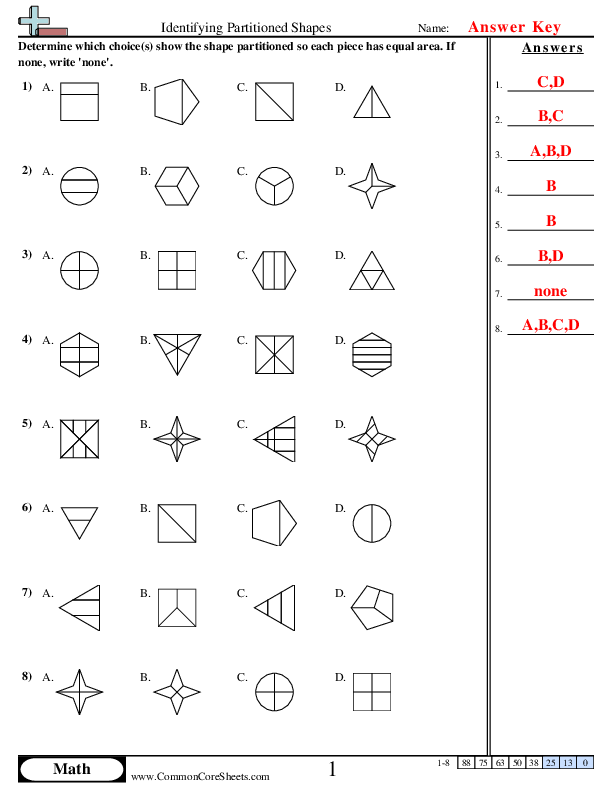
Identifying Partitioned Shapes
3g2


×
Description:
"This worksheet is designed to enhance children's understanding of partitioned shapes in mathematics. It comprises 8 interactive problems, promoting active learning in recognizing and differentiating various segmented shapes. Utilized as customizable flash cards, it serves as a fun and engaging tool for both classroom and distance learning. This versatile worksheet offers a dynamic approach to math education, fostering improved comprehension and retention.".

×
Student Goals:
Shape IdentificationAfter completing this worksheet, students should be able to identify a variety of partitioned shapes with increased accuracy and confidence. This process will help boost their geometric awareness and visual discrimination skills.Spatial UnderstandingBy working through spatially-oriented problems, students improve their ability to perceive and understand the spatial relationships among shapes. This skill is foundational in many areas, including higher mathematics, engineering and day-to-day spatial tasks.Critical ThinkingThis worksheet provides an opportunity for students to enhance their critical thinking skills. They will need to apply logic and reason, deducing the nature of the different partitioned shapes presented to them. Over time, this practice can lead to improved problem-solving abilities.Memory RecallStudents will exercise their recall skills in this worksheet. By identifying partitioned shapes that they've studied before, they strengthen their memory recall capabilities, which are essential in many learning environments and real-life scenarios.Pattern RecognitionThis exercise also promotes pattern recognition, a critical skill in mathematics and sciences. Recognizing patterns in shapes or sequences helps child to predict and understand natural and mathematical phenomena.Perseverance & ResilienceIn striving to solve the problems on this worksheet, students learn the importance of perseverance and building resilience. They are likely to encounter difficulties along the way, but these challenges will serve to motivate them to press on, thereby fostering a growth mindset.Application of KnowledgeCompleting this worksheet enables students to put into practice the knowledge they have learned in class. By actively engaging with the lesson content in a practical manner, they are more likely to internalize and retain the concepts and principles taught, leading to a deeper understanding of the subject matter.Mathematics AppreciationIn identifying and categorizing different partitioned shapes, students are exposed to the beauty and diversity of geometrical figures and the world of mathematics. This could potentially spur their interest and positively influence their attitude towards the subject.



Determining Zero, half and Whole with Fractions
3nf3d


×
Description:
"This worksheet is designed to help children grasp the concept of zero, half, and whole numbers in mathematics. With 20 customizable problems, it conveys understanding via visual fraction representations. Perfect for online or distance learning, the worksheet can also be converted into flashcards for a hands-on learning experience. Engaging for all learners, it makes mastering this essential math skill both accessible and enjoyable."

×
Student Goals:
Understanding of Fundamental ConceptsStudents completing this worksheet should have gained a solid understanding of fundamental mathematical concepts, specifically those related to fractions. With a focus on halves, wholes, and zeros, students will have a deeper comprehension of how these different components function within the broader context of mathematical operations.Problem Solving AbilitySuccessfully finishing this worksheet suggests students are able to approach and solve problems effectively. These math-based exercises will have required high level of logical thinking, precision, and a strategic approach to problem-solving. Completion of this task will have helped to develop these skills, fostering confidence and competency in not just mathematics, but also in a myriad of other areas that require problem-solving ability.Fraction ComprehensionThe worksheet ensures students are adept at evaluating and understanding the idea of a 'half' and 'whole' when dealing with numbers. The skills to determine and differentiate zeroes, halves and whole numbers from a given set, will aid them in further algebraic calculations and mathematical tasks involving fractions and rational numbers.Numerical FluencyAs students complete the worksheet, they'll enhance their numerical fluency, gaining the ability to swiftly and accurately go through numerical information and interpret it. This proficiency is fundamental in both, day-to-day life and academic studies, developing the student's overall mathematical competence.Critical Thinking and Analytical SkillsCompletion of this worksheet will also manifest students' abilities to critically analyze and comprehend mathematical problems, applying learned concepts to evaluate and solve them. Such skills will improve their analytical thinking in a way that is translatable not only in math, but also in various other academic and real-world scenarios.Preparation for Advanced MathematicsThe understanding of basic fractions and numbers achieved from this worksheet will lay a solid groundwork for students as they advance to higher mathematical concepts. It will provide them with the necessary confidence and knowledge to tackle complex mathematical theories and problems in the future.


Fraction Location on a Numberline
Link

Finding Fractions on Number Line
3nf2a


×
Description:
"This worksheet is designed to help children master the concept of fraction location on a number line. Offering 8 diverse problem sets, kids identify the correct placement of specific fractions. The worksheet is highly customizable to suit different learning requirements. It can be easily converted into flashcards for more interactive learning or utilized in distance learning platforms to facilitate math education beyond traditional classroom settings."

×
Student Goals:
Understand FractionsBy completing the worksheet, students should gain a solid understanding of fractions. This foundation will be crucial for them to grasp more complex numerical concepts in the future. They'll learn about number numerators and denominators, as well as how these components influence a fraction's value. The task demands students to visualize fractions on a number line, which helps them appreciate the relative sizes of different fractions and their relation to whole numbers. This understanding can then be applied in various real-life scenarios, such as measuring ingredients for cooking or calculating distances.Develop Problem-solving SkillsThe worksheet serves as an excellent tool for enhancing students' problem-solving abilities. Each problem poses a unique challenge that requires students to apply their knowledge and analytical skills to find the required fraction on the number line. Through this process, they learn to approach problems methodically, improve their critical thinking skills, and, most importantly, do not fear facing mathematical tasks. These problem-solving abilities are not only relevant to their math lessons but are also applicable to other subjects and real-world situations.Enhance Numerical LiteracyCompletion of this worksheet means that the students have enhanced their numerical literacy. This implies that they've been exposed to the skills necessary to interpret and work with numbers in all aspects of life, from budgeting to measuring and beyond. They'd understand how fractions fit into the broader picture of numerical literacy, appreciating their prevalence and relevance in daily undertakings. Importantly, this stage of numerical literacy is a stepping stone towards more difficult concepts, such as percentages and ratio calculations.Improve Visual-spatial UnderstandingWith a focus on mapping fractions on a number line. This worksheet promotes visual-spatial understanding. It trains students to mentally arrange and manipulate numbers and fractions within a defined space. It also challenges them to identify the relative positions of different fractions on the number line. Consequently, this understanding aids in the honing of spatial awareness which is beneficial in other areas of education such as geometry, engineering, physical sciences, and even day-to-day tasks that require spatial judgement.Boost Confidence in MathematicsLastly, upon completion of the worksheet, students should feel a lot more confident in their mathematical abilities. By mastering these foundational fraction-related tasks, they will realize that they are fully capable of understanding and conquering mathematical challenges. This new-found confidence can have a profound effect on their overall attitude towards learning and education, encouraging them to tackle more complex mathematical problems and concepts without hesitation.


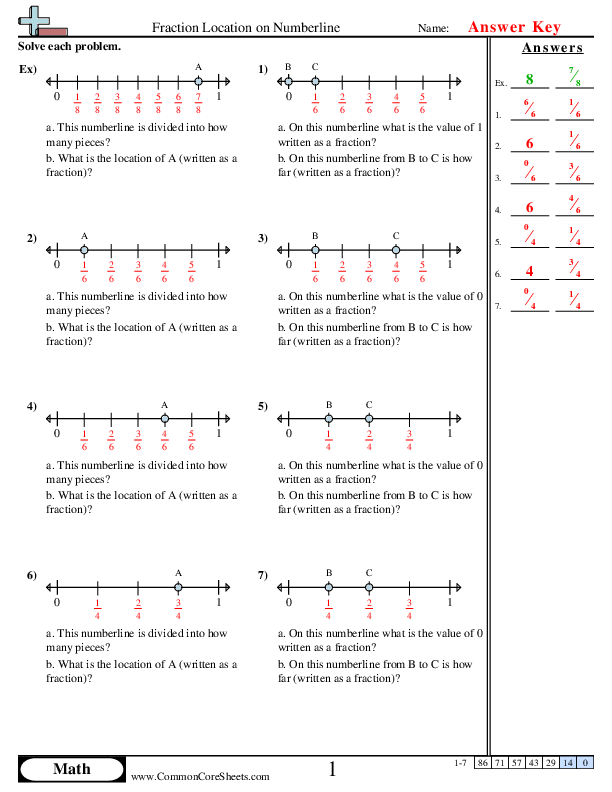
Determining Fraction Value on a Number Line
3nf2b


×
Description:
"This worksheet is designed to enhance children's understanding of fractions on a number line. Comprised of seven detailed math problems, it walks students through various aspects of fractions, including values and locations. The problems challenge students to identify fractional values and distances between points on various number lines. Adjustable for different learning levels, the worksheet can be customized, used as flashcards, or incorporated into distance learning curriculums to adapt to learning preferences and needs."

×
Student Goals:
Develop Numeracy SkillsAfter completing the worksheet, students will have greatly developed their numeracy skills. They will be capable of interpreting and locating fractions on a number line, a crucial concept in elementary mathematics. This understanding will be beneficial in the advancement of more intricate mathematical ideas and proficiencies in the future.Understand Division of Unit LengthsThe children will demonstrate an understanding that a number line is divided into unit lengths, and that different fractions or decimal points denote these divisions. Recognizing this foundational principle will enhance their skills in deeper mathematical categories like algebra, geometry, and more advanced categories of arithmetic.Knowledge of Real World ConnectionsThrough the worksheet, students will gain an understanding of how fractions and their location on a number line relate to real world situations. This could be in measuring distances, cooking, or understanding timelines, reinforcing the notion that math is not merely a theoretical subject, but has practical, everyday applications.Enhancement of Critical ThinkingThis worksheet encourages critical thinking and problem-solving abilities. From figuring out the value of points on a number line to comparing distances, students are challenged to think, analyze, and solve which fosters a much-required mindset for future mathematical and scientific learning.Effective CommunicationBy describing the location of various points on the number line as fractions, students will be developing their ability to communicate mathematical ideas and arguments effectively. This skill is vital not only in the scope of mathematics but also across different subjects and learning areas since clear communication is key in academic success and future professional pursuits.Improve AccuracyThrough repeatedly answering the problems provided, the children will improve their mathematical accuracy. This practice will lessen the probability of committing errors in calculations, which is a valuable skill in many areas of life requiring financial or statistical analysis.


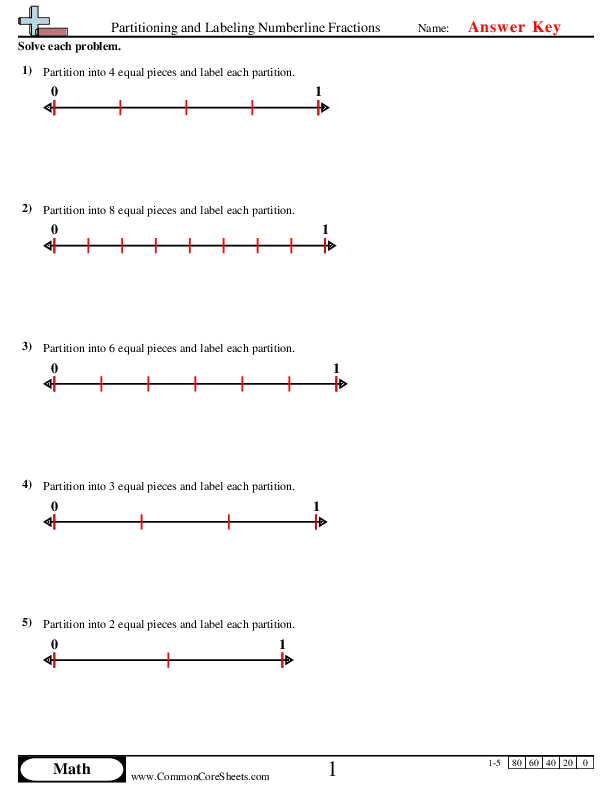
Partitioning and Labeling Numberline Fractions
3nf2a


×
Description:
"This worksheet is designed to help children grasp and master the concept of partitioning and labeling on number lines, demonstrating understanding of fractions. Comprised of five unique questions, students will partition number lines into 2, 3, 4, 6 and 8 equal pieces. It offers customizability for individual learning and can easily be converted into flashcards for an interactive experience. Moreover, it's perfectly suitable for distance learning. This worksheet illuminates math concepts, making them approachable and comprehensible."

×
Student Goals:
Understanding of Fractional ConceptsUpon completing this worksheet, students should have a solid understanding of basic fractional concepts. They will learn that a fraction represents a part of a whole and that different fractions can represent the same value (for example, 2/4 and 1/2). Understanding fractions is crucial as it lays the foundation for more complex mathematical concepts in the future.Proficiency in Partitioning NumberlinesThe worksheet also equips students with the skill to accurately partition number lines into equal segments. This ability allows them to visually represent fractions and better understand their underlying principles. Partitioning is a critical skill for understanding interval scale and shapes the students' ability to deal with both ratio and proportion.Improved Numerical Labeling SkillsAfter finishing the worksheet, students will have improved proficiency in labeling each partition on the number line with corresponding fractional values. This enhances their number sense, links fractions to linear measurement, and cultivates their understanding of the relative nature of number size. This skill directly feeds into the ability to interpolate in missing number sequences and handle data interpretation in graphical forms such as bar and line graphs.Enhanced Comparison SkillsChildren will develop the ability to compare fractional values by analyzing number lines. This can be a practical way for them to understand that with fractions, a bigger denominator does not necessarily mean a larger value – an essential principle that students often struggle with in early fractions work.Introduction to Equivalent FractionsThough it is not explicitly mentioned in the worksheet, students will begin to develop intuition for the concept of equivalent fractions. They may notice, for example, that partitioning a number line into 4 pieces and shading in 2 will visually look the same as partitioning into 2 pieces and shading in 1 (i.e., that 2/4 = 1/2). This preps them for later math instruction where equivalent fractions are formally introduced.Building a Foundation for More Advanced Fractional ConceptsFinally, this worksheet provides a strong foundation for the learning of more advanced fractional concepts in the future. When they understand where fractions come from and how they work on a number line, they will find it much easier to grasp operations with fractions like addition, subtraction, multiplication, and division.



Identifying Fraction Location on a Number Line
3nf3c


×
Description:
"This worksheet is designed to enhance a child's understanding of converting fractions to whole numbers, helping to solidify their base in math. Containing 16 diverse fraction problems, it allows students to visualize numbers and conceptualize fractions. This versatile tool can be customized to suit any learner's needs, converted into flashcards for interactive learning or adopted in long-distance learning scenarios. The perfect adjunct to any math curriculum, empowering smarter and efficient learning."

×
Student Goals:
Understanding of FractionsAfter completing this worksheet, students should have a strengthened comprehension of fractions as expressions of whole numbers. They would gain the ability to recognize and mark fractions on a numerical scale, understand their relative proportions, and visualize their equivalence to certain whole numbers. This solidifies their fundamental grasp on the concept of fractions, laying the groundwork for more complex mathematical computations.Ability to Convert Fractions to Whole NumbersStudents will develop the skill to convert fractions into whole numbers. They will learn that when the numerator and the denominator of a fraction are the same, the fraction amounts to the whole number one. This skill will be integral to their progression within the subject of math as they progress to more complex topics, like algebra.Mathematical ReasoningBy working through the problems on this worksheet, students will enhance their mathematical reasoning skills. They will make logical deductions to decipher the location of fractions along a number line, thus building their aptitude in quantifying fractions of a whole. Their ability to think critically, reason logically, and make accurate mathematical judgments will be greatly improved.Competence in Numerical RepresentationThis worksheet will train students to efficiently translate numerical data into visual formats. They will mark the location of various fractions on a number line, thereby converting abstract numbers into concrete, visual representation. This not only helps in enhancing their comprehension but also promotes their skills in data representation, an important competency in various academic and professional fields.Confidence in Handling FractionsLastly, by successfully completing this worksheet, students will have gained the necessary confidence to approach fraction-based problems. Fear or hesitation towards fractions is a common phenomenon among young learners. However, with practice and subsequent mastery of the topic, this anxiety can be mitigated. By building their knowledge and understanding, this worksheet will help foster the students' confidence, influencing not just their performance on future worksheets and exams, but also their enthusiasm towards learning.


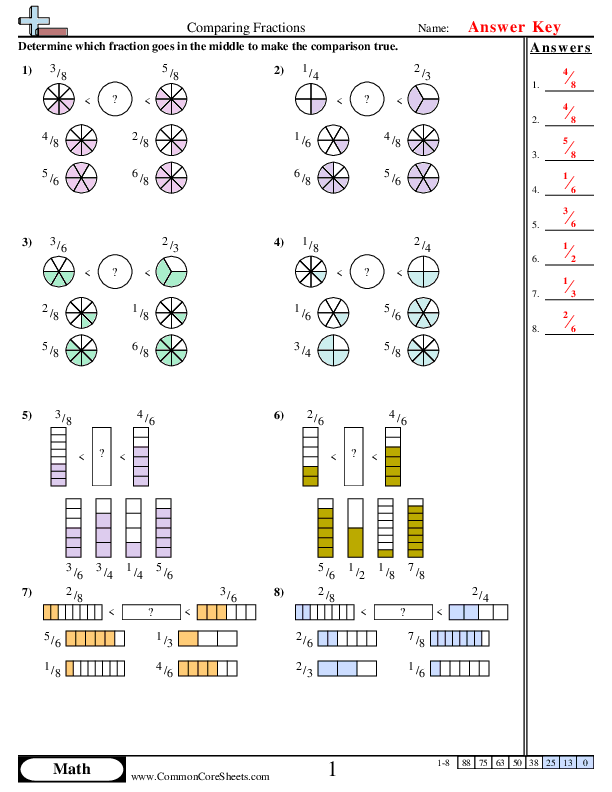
Comparing Fractions
3nf3d


×
Description:
"This worksheet is designed to sharpen kids' math skills by comparing fractions. It offers 8 diverse problems that challenge students to recognize and analyze fractional equivalency and inequality. Customizable to individual learning needs and pace, it can be converted into flash cards for interactive study sessions. It's also suitable for distance learning, providing a fun and engaging way to master fractions at home."

×
Student Goals:
Understanding FractionsAfter completing the worksheet, students should develop a strong grasp of fractions, understanding the concepts of numerators and denominators. This fundamental understanding of fractions is vital for many mathematical problems and everyday scenarios. The concept directly plays into understanding divisions, ratios, proportions and is used extensively in higher mathematical studies and various fields of science, engineering, and data analysis.Comparing FractionsThe ability to correctly compare fractions is a crucial outcome of this worksheet. This competence builds familiarity with numbers and enhances logic by comparing two or more fractions to determine which is greater, smaller or if both are equal. Such a skill is not only valuable in academics and number-based fields but also aids in reasoning, logical thinking and decision-making in everyday life.Problem Solving and Critical ThinkingIn the process of completing the worksheet, students will be required to solve multiple problems involving the comparison of fractions. Each problem is a chance to exercise their problem-solving skills and critical thinking abilities, which are key components in their cognitive development and future learning processes. These functions are applicable in many other areas of study and life situations that require planning, organization, and decision making.Confidence in Fraction ManipulationSuccessfully completing the worksheet should result in higher confidence levels in handling fractions. The mental exercise of manipulating numbers in fractions, comparing and understanding their relative magnitudes, can significantly boost a student's self-assurance in managing mathematical problems around fractions. This confidence is fundamental for tackling more complex mathematical problems in future academic pursuits.Basis for More Complex Mathematical ConceptsStudents should be able to use the knowledge gained from this worksheet as a foundation for understanding more complex mathematical concepts. These include but are not limited to ratios, decimals, percentages, and algebraic equations. This foundational knowledge in fractions and their comparison is crucial for branching out into these different yet interlinked mathematical topics.



Determining Fraction - Visual
3nf1


×
Description:
"This worksheet is designed to teach children about fractions through visualization. With ten interactive problems, students are asked to identify the shape that correctly represents certain fractions. Every problem can be customized to meet individual learning needs. Notably, its dynamic nature makes it suitable for use in distance learning, and each problem can also be transformed into fascinating flashcards."

×
Student Goals:
Conceptual Understanding of FractionsUpon the completion of this worksheet, students should have a firm understanding of fractions - the basic concept and how they represent parts of a whole. They will be able to identify and determine fractions in a visual and intuitive manner, strengthening their grasp on the subject.Mastery in Fraction VisualizationStudents will master the technique of visualizing fractions as part of a shape. They will be confident in identifying which part of a shape represents certain fractions. This skill significantly helps in comprehending more complex mathematical problems as they progress in their coursework.Problem-Solving AbilityBy solving a variety of fraction problems, students sharpen their problem-solving abilities, critical thinking, and analytical skills. They should be able to apply these skills not only to similar math problems but to real-life situations as well, demonstrating a practical understanding of fractions.Comparison of FractionsAfter completing the worksheet, students will be able to compare different fractions visually. This skill makes it easier for them to grasp the concept of fraction equivalency, simplification, and comparison - foundational skills in further mathematical education.Fosters Independent LearningThis self-guided exercise bolsters independent learning. The confidence earned from successfully solving the problems promotes self-reliance in their learning journey, fostering a willingness to tackle new, more demanding topics autonomously.Enhanced Numeracy SkillsWith each fraction problem, the pupil refines their numeracy skills. The ability to determine fractions visually aids cognitive development, enhances numeric literacy, and lays a formidable foundation for more complex mathematical computations.



Comparing Fractions
3nf3d


×
Description:
"This worksheet is designed to help children master the concept of comparing fractions using visuals and problem-solving exercises. With nine problems presented in interactive formats, it encourages learning through various methods. The content is customizable for specific learning requirements and can easily be adapted into flash cards for more engaging study. This worksheet is versatile and ideal for use in both traditional and distance learning environments, facilitating better understanding of fractions in a fun and interactive way."

×
Student Goals:
Understand Fraction ConceptsBy successfully completing this worksheet, students will have significantly improved their understanding of fractions. This fundamental concept in math is used in a variety of subjects and is crucial in later learning. They will learn how fractions work, along with its components: the numerator and denominator. Their confidence in dealing with fractions will be enhanced.Skills in Comparing FractionsThe worksheet is designed to help students improve their skills in comparing fractions. They will grasp how to identify the larger or smaller fraction by interpreting the numerator and denominator correctly, train their mental math skills, and enhance their ability to follow logical steps in comparing fractions of different values. This skill is not only important in math but also relevant in real-life situations where comparisons have to be made.Problem-Solving ProficiencyAfter tackling the problems in this worksheet, students will improve their problem-solving skills. They will learn to apply theory to practice, fostering the ability of critical thinking. Each problem in this worksheet has been designed to challenge their comprehension, requiring them to analyze, strategize and then solve it. This strengthens their ability to approach, dissect and resolve problems effectively.Exercise Patience and DiligenceThe worksheet encourages students to be patient and diligent. Fractions require a certain degree of focus and a lot of practice to master. By diligently working through the problems, students will learn the importance of perseverance in achieving their learning goals. This enhances their attitude and behavior in learning, making them better learners.Develop Math FluencyThis worksheet offers students an opportunity to enhance their math fluency. They will engage with fractions regularly and this repeated practice contributes towards making them comfortable and fluent in handling fractions. A high level of fluency will benefit students in faster and more efficient problem-solving. It will also be beneficial in their future mathematical undertakings.


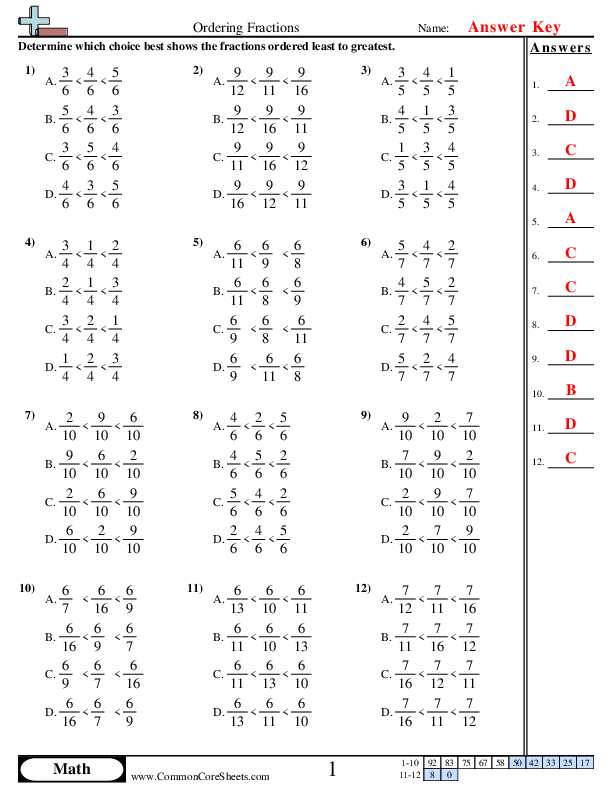
Ordering Fractions (Multiple Choice)
3nf3d


×
Description:
"This worksheet is designed to enhance a child's math skills in ordering fractions. Covering 12 engaging problems, each example presents different fractions that provoke critical thinking skills. Adaptable to various learning styles, this worksheet can be customized into flashcards or used for distance learning, proving effective even beyond traditional classroom environments. A perfect tool for both teachers and parents to develop essential math understanding in children."

×
Student Goals:
Understand FractionsAfter completing this worksheet, students should have a strong understanding of fractions, knowing what they are and how they are represented. They will become more familiar with the numerical representation of fractions, and the difference between the numerator and denominator. This understanding will form the basis for their mathematical knowledge going forward, forming the prerequisite for more advanced concepts.Ordering FractionsStudents will gain the ability to order fractions correctly. They will learn to determine which fractions are larger or smaller and understand the concept of comparative values within the fraction context. They will understand that fractions can represent values greater than, less than, or equal to other fractions and will develop the ability to make such comparisons accurately and efficiently.Enhance Problem-Solving SkillsBy working through the problems in this worksheet, students will enhance their problem-solving skills. These challenges promote critical and analytical thinking as learners navigate through to the solution. They will learn to apply the concepts they've learned about fractions to solve problems, improving their overall mathematical problem-solving capabilities.Increase Confidence in MathRoutinely working through problems such as those found in this worksheet fosters confidence in a student's mathematical abilities. As they quickly recognize and accurately order fractions, they will feel more comfortable tackling complex mathematics questions. This boost in confidence can significantly impact their future performance in math and their enthusiasm towards learning new math concepts.Preparation for Advanced Mathematical ConceptsMastering the technique of ordering fractions forms a solid foundation for tackling more complex mathematical concepts in the future, including algebra and calculus. The skills gained through this worksheet are transferrable and will be essential as they continue their math education. They will be better prepared and have the confidence to solve increasingly complex problems and equations.



Comparing Fractions (same numerator or denominator)
3nf3d


×
Description:
"This worksheet is designed to enhance children's mathematical skills by focusing on comparing fractions. Consisting of 20 problems that utilize graphical representations, it simplifies the measurement of different quantities. Customizable for diverse learning methods, it can be converted into flashcards for kinesthetic leaners or implemented digitally for distance learning. Perfect for mastering the concept of fractions and improving numerical proficiency."

×
Student Goals:
Understand Basic FractionsUpon completion of this Comparing Fractions worksheet, students should have a solid understanding of fractions, which represent part of a whole. Through solving 20 problems, they'll learn to identify the numerator and denominator, and understand their significance in representing fractions in the simplest form, leading to a more natural comprehension of fractions.Proficiency in Comparing FractionsThe worksheet fosters proficiency in comparing fractions. By solving problems, students will learn the rules for fraction comparison, like comparing numerators for fractions with the same denominator or comparing the whole numbers for fractions with the same numerator. This skill is incredibly crucial for advancement in math topics, including algebra and calculus.Building Mathematical ConfidenceThis worksheet aims to build students' confidence in their mathematical ability. By successfully comparing fractions, students will see their progress in math competency, fostering a sense of achievement and encouraging them to tackle more complex mathematical problems. This newfound confidence can enhance their interest in math and lead to higher academic achievement.Critical Thinking and Problem-SolvingCompleting the worksheet helps develop critical thinking and problem-solving skills. Students must utilize logical thinking to evaluate the fractions and judge their relative size. Over time, repeated practice of these skills not only aids mathematical learning but also strengthens overall cognitive development, which is beneficial across all academic disciplines.Preparation For More Advanced Math ConceptsMastering fraction comparison is a key stepping stone to more advanced math concepts. Successfully completing this worksheet helps prepare students for more complex numerical concepts, including ratio, proportions, and decimals, integral for more advanced Math topics. This will set a strong foundation for students' mathematical journeys, equipping them to tackle higher-level mathematical problems.


Equivalent Fractions
Link
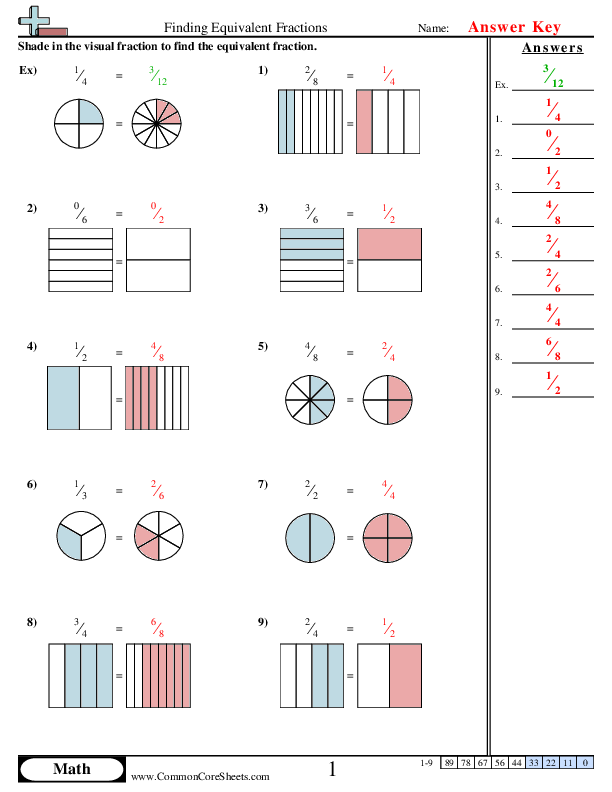
Finding Equivalent Fraction (visual)
3nf3b


×
Description:
"This worksheet is designed to help children understand the concept of equivalent fractions in mathematics, using visually-appealing and clear examples. With 9 problems to solve, learners can engage in a hands-on approach to mastering this fundamental math topic. It offers multiple options as it can be customized to meet the learner's pace, converted into convenient flashcards for revision purposes, or seamlessly integrated into distance learning curriculums. This innovative learning tool merges fun and education."

×
Student Goals:
Understanding Equivalent FractionsUpon successfully completing the worksheet, students should have a comprehensive grasp on equivalent fractions. The ability to confidently identify and develop equivalent fractions is a fundamental part of progressing in the understanding of math. As equivalent fractions hold the same value, despite their different appearances, navigating the intricacies of their relationships is essential.Improving Fraction SimplificationThe presented problems on the worksheet incrementally introduce students to fraction simplification. By reinforcing the underlying principles of reducing fractions to their simplest form, pupils will improve their fraction simplifying abilities. This consolidates their knowledge of fractions in general, building a solid foundation for more advanced mathematical problems.Developing Skills in Problem SolvingExposed to a range of problems, the children will hone their problem-solving skills. The ability to approach questions from different angles is a key objective of this worksheet. Beyond mathematical proficiency, this skill is crucial for general learning and grappling with complex issues across various subjects.Increasing Confidence in Handling FractionsChildren will gain confidence in handling fractions, thereby reducing numeracy anxiety and improving academic performance. With proficiency in dealing with fractions, students should feel comfortable with numerical concepts, encouraging overall engagement in studying mathematics.Promoting Mathematical ReasoningThis exercise promotes the pupil's mathematical reasoning, nurturing their ability to identify patterns and relationships between numbers. The workbook serves to help students make links between different areas of mathematics, contributing to comprehensive and diverse mathematical proficiency.Enhancing Numerical FluencyGradual exposure to and practice of these problems will enhance student’s numerical fluency. With the visualization and normalization of fraction problems included, children will naturally begin to recognize common fraction problems and correlations between different fractions, promoting a stronger sense of number sense and ease with distinguishing numerical values.



Equivalent Fractions With Numberlines
3nf3a


×
Description:
"This worksheet is designed to help children understand and find equivalent fractions using number lines. By presenting eight diverse problems, it aids in converting abstract fraction concepts into visible representations. Each problem encourages the identification of equivalent fractions, fostering a solid grip on basic mathematical principles. Customizable for differing learning levels, this worksheet is an excellent resource for distance learning and can readily be transformed into flashcards for interactive education."

×
Student Goals:
Understanding Basic Fractions ConceptsAfter completing this worksheet, students should have a deep understanding of fundamental fraction concepts. They should be able to clearly define fractions and their parts (numerator and denominator), know how to ascertain fractions on a number line, and comprehend how fractions relate to the concept of division and portions.Develop Skill in Finding Equivalent FractionsStudents will acquire the crucial skill of determining equivalent fractions. Equivalent fractions are fractions that, despite having different numerators and denominators, represent the same proportion of a whole. By comparing fractions on a number line, students can visually interpret and identify equivalent fractions, thus reinforcing this key mathematical concept.Enhance Problem-Solving SkillsBy working on the worksheet, students will enhance their problem-solving skills, critical in mathematics. They should be capable of using established strategies (like using a number line) to solve a problem, analyze and interpret their results, and adjust their methods if necessary, thereby boosting their problem-solving abilities and cultivating mathematical thought.Improve Number SenseCompleting problems involving equivalent fractions on a number line will help students to establish better number sense. Number sense, the understanding of number relationships and the ability to make logical decisions about numbers, is a crucial part of early math learning. Students should have improved their ability to visualize and comprehend how numbers, particularly fractions, fit together.Foster Precision and AccuracyStudents should have cultivated precision and accuracy in their mathematical workings. From setting out their solutions neatly, to correctly positioning fractions on a number line, to accurately determining equivalent fractions - this worksheet will have taught the students to value accuracy in their computations and representations, a critical skill for more advanced math work.Promote Autonomy in LearningLastly, the worksheet encourages students to take charge of their learning by working independently. They should be able to complete similar exercises on their own, using the techniques and comprehension they've developed, fostering an attitude of self-reliance and confidence in their math abilities.


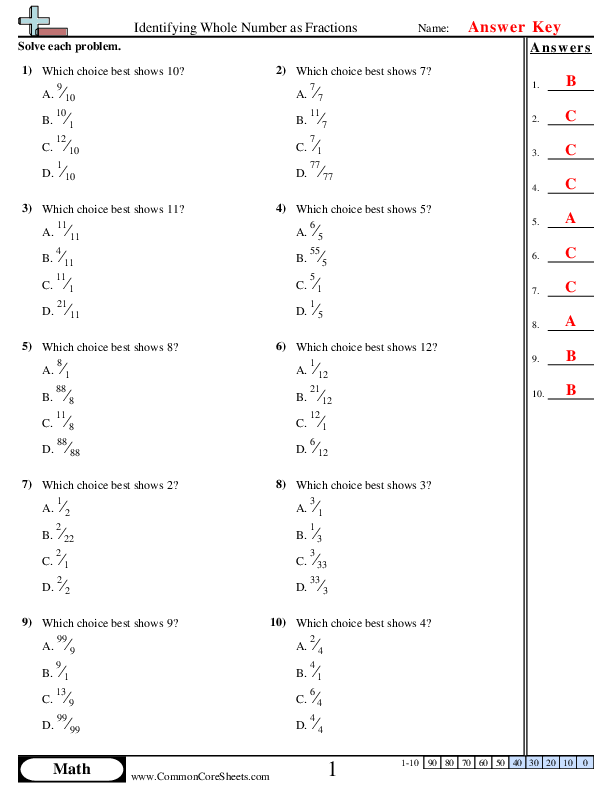
Identifying Whole Number as Fractions
3nf3c


×
Description:
"This worksheet is designed to teach children the concept of interpreting whole numbers as fractions. With 10 interactive problems, learners are tasked to identify whole numbers represented by different fractions. Adaptable to multiple learning formats, the worksheet can be customized, transformed into flash cards, or effortlessly incorporated into distance learning programs, making math engaging and accessible for young learners."

×
Student Goals:
Understanding of FractionsUpon completion of the worksheet, students should have an enhanced understanding of fractions. They will be familiar with the concept that whole numbers can also be represented as fractions as they can identify different fractions that correspond to the same whole number. This will significantly improve their ability to manipulate and work with fractions, an essential component of mathematics.Problem-solving SkillsThis worksheet aids in developing problem-solving skills among students. They will learn to apply their mathematical knowledge to identify or select the best fractional representation of a given whole number. Through this process, students gain experience in breaking down problems and making informed decisions, thus cultivating their problem-solving abilities in general.Increased AccuracyRegular practice with such worksheets increases accuracy in handling fractions. This improved accuracy will come in handy while dealing with more complex mathematical problems later on. It will also reduce the likeliness of making errors, enhancing students' overall mathematical competence.Foundation for Advanced TopicsCompleting this worksheet lays a strong foundation for learners to understand and grasp more advanced mathematical topics. The understanding that whole numbers can also be fractions forms the basis of many complex mathematical applications and is crucial for later subjects such algebra and trigonometry.Confidence BoostSuccessfully completing this worksheet will boost students' confidence in their mathematical abilities. This confidence often translates into increased participation in class and improved performance in tests and exams. Confidence in one's mathematical abilities is crucial for academic success in this subject and can also fuel interest in learning more advanced mathematical concepts.Mathematical Language UnderstandingThis worksheet also helps students in understanding and using the mathematical language effectively. They acquire the ability to read, interpret, and write mathematical equations accurately, thus improving their mathematical communication skills.


Converting Fractions
Link

Fractions to Whole Numbers
3nf3c


×
Description:
"This worksheet is designed to enhance children's math skills by focusing on converting fractions to whole numbers. With 20 unique problems, examples include transforming fractions such as 32/8, 90/10, and 56/8 into whole numbers. The customizable nature allows this worksheet to be converted to flashcards or adopted in distance learning scenarios, providing a versatile approach to mastering essential math concepts."

×
Student Goals:
Understanding of Fractions and Whole NumbersUpon successful completion of this worksheet, students should have a clear understanding of the relationship between fractions and whole numbers. This understanding serves as a fundamental building block in grasping the broader concepts in mathematics. The exercises included allow students to transform fractions into their equivalent whole numbers, strengthening their knowledge and application of division and multiplication.Enhanced Computational SkillsWorking through these problems encourages students to apply their mental math skills, specifically in division. This strengthens their overall arithmetic abilities, and with regular practice, students should find that these computations become easier and quicker.Critical Thinking and Problem-Solving SkillsEach fraction to a whole number problem requires students to use problem-solving and critical thinking. They need to recognize the relationship involved in changing fractions to whole numbers. This will improve their ability to analyze mathematical equations or problems and develop strategic ways to find solutions.Familiarity with Number PatternsSolving these fractional problems also allows students to notice number patterns, which is an integral part of number sense. Observing how numbers relate to each other in fractions and how they translate into whole numbers will help build logic and reasoning skills.Boosted Confidence with MathThis worksheet provides a gradual progression in its difficulty level from simpler to more complex transformations. Upon completion, students should gain confidence in handling fractions and whole numbers, ultimately making them feel more at ease with the subject of Math.Preparation for More Advanced Math TopicsThe core concepts of fractions and whole numbers form the basis for more complex mathematical topics that students will encounter later on, such as ratio and proportion, geometry, and algebra. Hence, mastering this worksheet aligns with preparing students for advanced math endeavors.




















